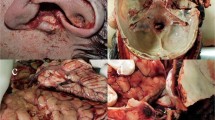Abstract
In contrast to skin wounds the characteristic forensic features of lesions of ligaments and tendons have rarely been investigated. However, in a suspected homicide the question became crucial whether an isolated discontinuity of the posterior atlanto-occipital membrane was caused by a rupture mechanism or by a cut. In order to re-evaluate the associated criteria experimental lesions were made in ligaments and tendons and examined histologically. From these experiments the following criteria could be established:Lacerations exhibit complete destruction of the tissue texture with microruptures and splitting of fibres in the adjacent region. Such wound edges have an irregular structure and fibres near the rupture site exhibit variable thicknesses due to traction.Incisions exhibit smooth wound edges with no disturbance of the tissue texture. The thickness of fibres near the rupture site is regular. These results were obtained by light microscopical examination and confirmed using electron microscopy. Under controlled experimental conditions the forces necessary to rupture tendons with a diameter of 1 mm varied between 50–70 Newton (N). In the suspected homicide, the lesion of the posterior atlanto-occipital membrane was examined visually and histologically and was compared with the experimentally established criteria. Based on these criteria the lesion could be identified as an incision which had probably been caused accidentally while severing the medulla during the first autopsy and was therefore not connected with the cause of death.
Similar content being viewed by others
References
Bargmann W (1977) Histologie und mikroskopische Anatomie des Menschen. Thieme, Stuttgart New York, pp 116–118
Claes L (1987) Sehnen. Biomechanik. In: Mohr W. Pathologie des Bandapparates. (Spezielle pathologische Anatomie Bd. 19) Springer, Berlin Heidelberg New York, pp 46–47
Hofmann v. ER, Haberda A (1927) Lehrbuch der gerichtlichen Medizin. Urban & Schwarzenberg, München Wien Baltimore, pp 300–317
Janssen W (1977) Forensische Histologie. Schmidt-Römhild, Lübeck, p 86
Knight B (1991) Forensic pathology, Edward Arnold, London Melbourne Auckland, pp 123–163
Kratter J (1921) Lehrbuch der gerichtlichen Medizin. Enke, Stuttgart, pp 326–330
Mueller B (1975) Gerichtliche Medizin. Springer, Berlin Heidelberg New York, pp 359–395
Polson CP, Gee DJ (1973) The essentials of forensic medicine. Pergamon Press. Oxford New York, pp 96–156
Sances A, Myklebust J B, Larson S L, Cusik J F, Weber R C, Walsh P R (1981) Bioengineering analysis of head and spine. Crit Rev Bioeng 5: 79–122
Stucker K (1951) Sehnenbelastung und -ruptur im Tierversuch. Chirurg 22: 16–18
Unterhamscheidt F (1992) Traumatologie von Hirn und Rückenmark. Pathologie des Nervensystems 7. (Spezielle pathologische Anatomie Bd13) Springer, Berlin Heidelberg New York, p 18
Wilhelm K, Steger ER, Schmidt GP (1973) Eine neue Versuchsanordnung zur Belastbarkeitsprüfung von Achillessehnen. Res Exp Med (Berl) 160: 80–88
Zink P (1965) Methoden zur Bestimmung der mechanischen Eigenschaften der menschlichen Leichenhaut. Dtsch Z Gerichtl Med 56:343–370
Author information
Authors and Affiliations
Rights and permissions
About this article
Cite this article
Du Chesne, A., Fechner, G. & Brinkmann, B. The distinction between lacerations and cuts in ligaments and tendons. Int J Leg Med 109, 1–4 (1996). https://doi.org/10.1007/BF01369593
Received:
Revised:
Issue Date:
DOI: https://doi.org/10.1007/BF01369593



